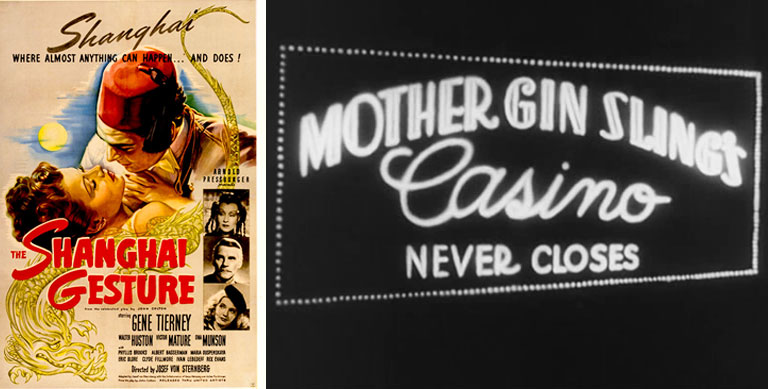"The Furniture" is our weekly series on Production Design. This week Daniel Walber looks back at one of the Art Direction Oscar nominees of 1942 for its 75th anniversary.
While Josef von Sternberg’s The Shanghai Gesture was still in production, the studio received a letter from T.K. Chang, the Chinese Consul to Los Angeles. Having read the script, he objected to its vicious and absurd portrayal of Shanghai’s underbelly and cautioned the producers to take “consideration of Chinese sentiment.”
Producer Arnold Pressburger defended the film as merely a fantasy. “This imaginary world has no connection with the realistic aspects of today,” he replied. This argument even wound up in the final cut, in the form of an opening title card: “Our story has nothing to do with the present.”

Chang saw right through Pressburger’s nonsense. “Such imaginations always prove to be constructed from the raw material of realities,” he wrote back. He was right. The Shanghai Gesture attempts a menacingly ahistorical flare by appropriating specifically Chinese decor. This is, of course, impossible. But the Oscar-nominated failure of art director Boris Leven (West Side Story) is fascinating...
Much of the film takes place in the casino of Mother Gin Sling (Ona Munson), reigning queen of Shanghai’s underbelly. Her empire has been threatened by an Englishman named Sir Guy Charteris (Walter Huston), whose real estate ambitions require demolition of the Red Light District. Mother Gin Sling defends herself with patience and intrigue, eventually unleashing a series of bombshell revelations.

The casino is enormous, lit up by sparkling chandeliers and elaborately carved railings. Its architecture is reminiscent of a pre-modern map of the universe, or a relief drawing of Dante’s Hell. Concentric circles of gambling tables descend into a pit, the bottom of which features high stakes roulette.

It is at this table where Poppy (Gene Tierney) will rack up mountains of debt, urged on by Dr. Omar (Victor Mature). Behind the table, a man inspects the valuables offered up as collateral by desperate gamblers. He sends authentic items up in a basket, which rises through the circles of Hell on a string.

The casino’s back rooms, therefore, come as a shock. The walls are bare. The few decorative elements resemble museum pieces, suggesting both wealth and Chinese-ness in the simplest possible terms. This grand carving, which appears taken right out of an ancient cliff, sits alone in a hallway.

Mother Gin Sling’s office is equivalently minimalist, featuring this sculpture that looks like a Tang Dynasty funerary camel.

These rooms belie Pressburger’s argument. The Shanghai Gesture may have nothing to do with the reality of China, but it is utterly dependent on its iconography. The same is true of the dining room in Mother Gin Sling’s home, where she arranges a New Year meal that will unravel the lives of everyone involved. The room is dominated by its decorative walls, painted by Chinese-American actor Keye Luke. The principal actors, none of whom are Chinese, are now quite literally surrounded by a simulacrum of Chinese art history.

Midway through the dinner party, the windows are opened so that the gathered guests may observe an annual spectacle. Women hang above the street in cages, from which they will be auctioned off. But as Mother Gin Sling explains, these women aren’t actually being sold. It’s just a show for the tourists. This narrative falseness, incidentally, is why it was allowed by the production code. Scandalous falsifications of Chinese culture were welcome, provided they not be scantily clad.

Pressburger was right, in a sense, that the film isn’t really about China. But this is because it only uses Chinese design as a means to an end. Each object, to borrow a concept from film scholar Homay King, is an “enigmatic signifier.” The Shanghai Gesture uses Chinese design to create an atmosphere of mystery. An entire culture is reduced to a vaguely seedy visual shorthand for secrecy and the unknowable.
This, of course, is not a phenomenon exclusive to The Shanghai Gesture. It continues into Chinatown, Blade Runner, Lost in Translation and others. The excuse that fantasy places a film’s images above reproach is also still very much alive. It can therefore be clarifying to look back at a film as transparent The Shanghai Gesture. Design may be appropriated to signify a vague “unknowable,” but that doesn’t mean we don’t know it when we see it.